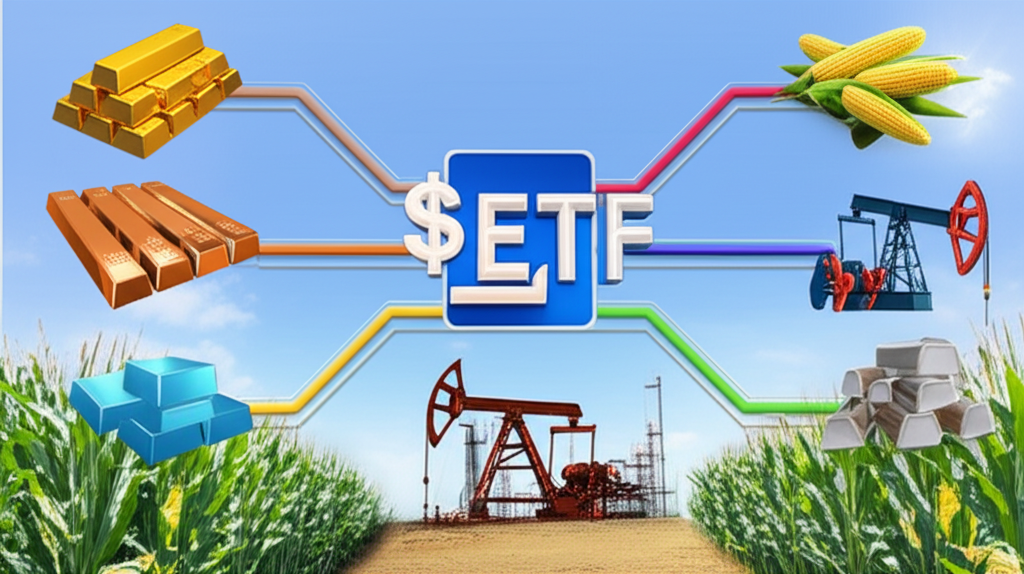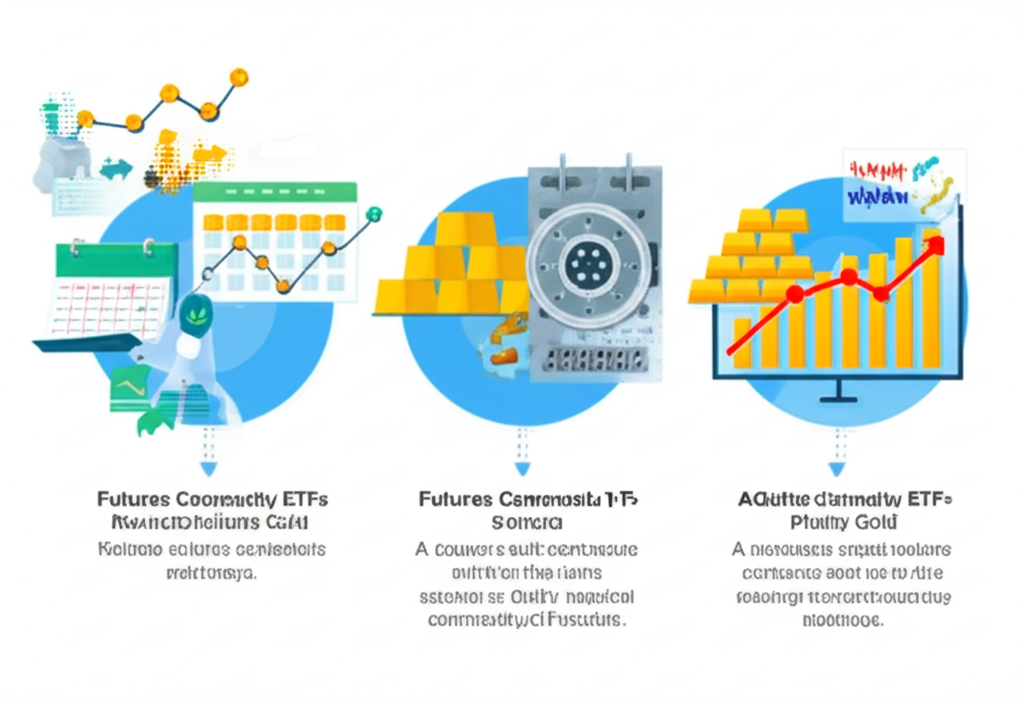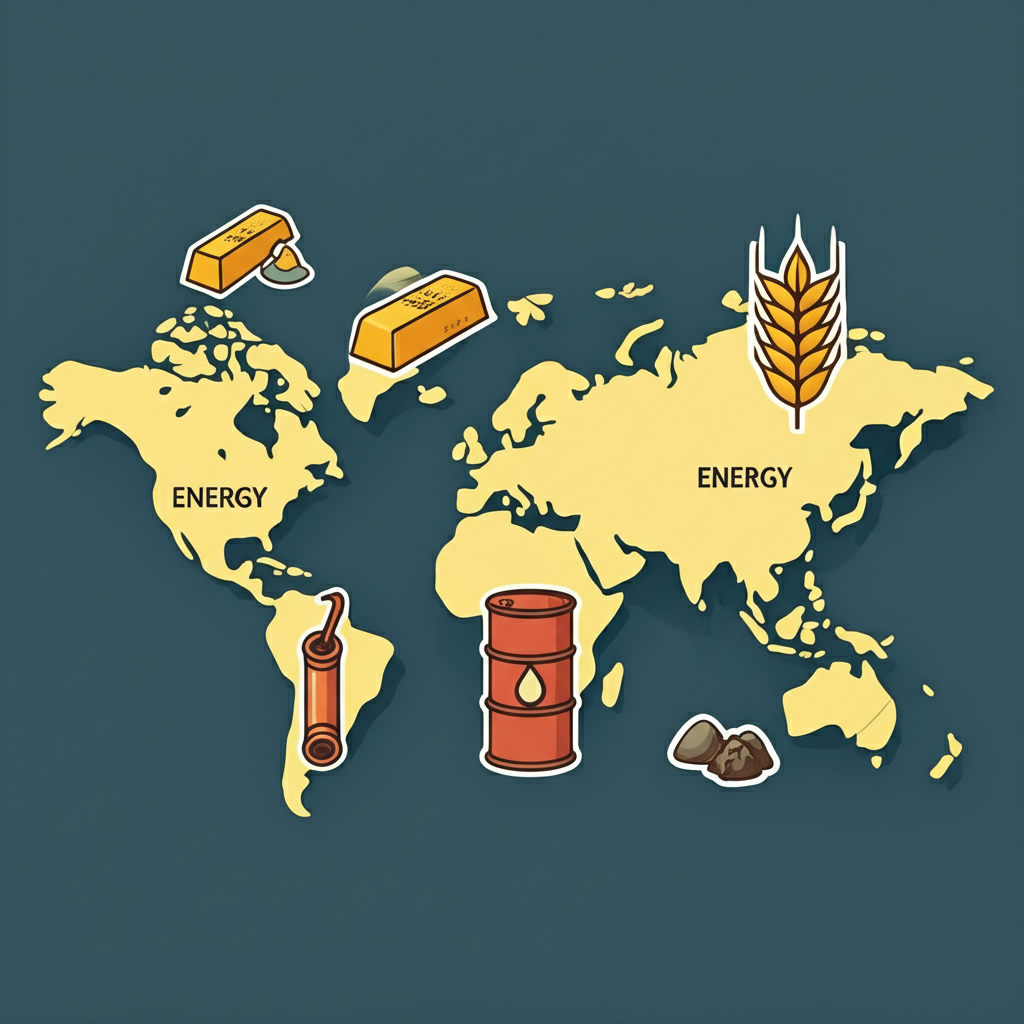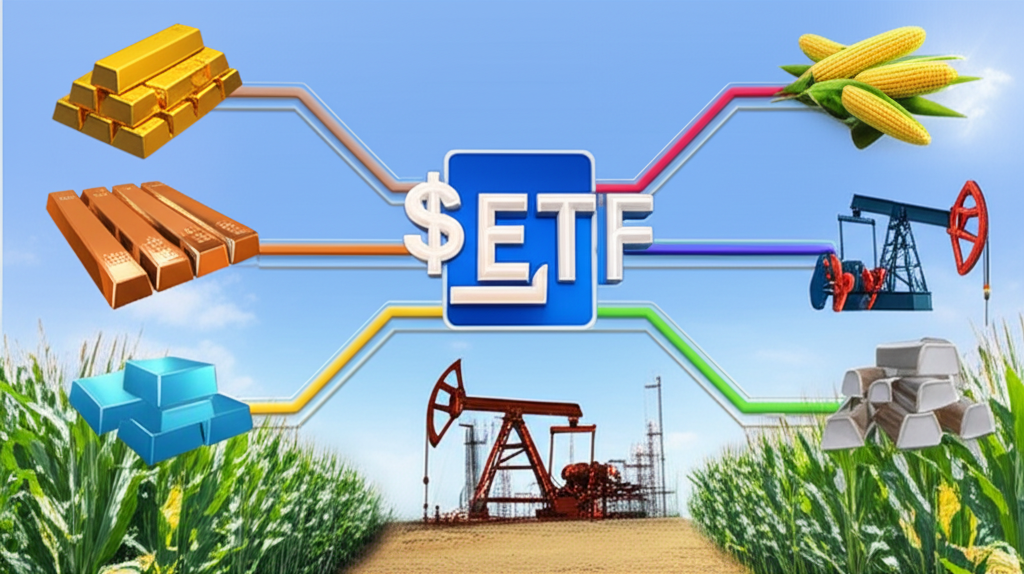Introduction to Commodity ETFs: What They Are and Why They Matter
Commodity Exchange Traded Funds (ETFs) have emerged as a powerful tool for investors seeking exposure to raw materials without the logistical hurdles of owning physical assets or navigating complex derivatives markets. By pooling capital from multiple investors, these funds offer a streamlined way to gain access to markets in crude oil, natural gas, gold, silver, corn, and industrial metals—all through a simple brokerage trade. Unlike direct commodity ownership, which involves storage, insurance, and transportation, commodity ETFs provide a liquid and accessible alternative. Their appeal goes beyond convenience: many investors turn to them as a strategic hedge against inflation, leveraging the tendency of commodity prices to rise when purchasing power declines. Additionally, they introduce diversification benefits, often moving independently of traditional stocks and bonds. Understanding how these funds operate—whether through futures contracts, physical holdings, or equity exposure—is essential for integrating them effectively into a well-rounded investment strategy.

Key Characteristics and Structures of Commodity ETFs
Not all commodity ETFs function the same way. The structure of a fund—how it gains exposure to its underlying asset—can significantly influence performance, risk, and tax implications. Investors must understand the three primary approaches: futures contracts, physical holdings, and equity-based investments.
- Futures Contracts: The most widely used method, particularly for energy and agricultural commodities, involves investing in futures contracts. These are agreements to buy or sell a commodity at a set price on a future date. While this structure allows for broad market exposure, it introduces unique challenges such as roll yield dynamics. For example, the United States Oil Fund (USO) tracks crude oil prices primarily by holding near-month futures contracts, making its performance sensitive to market conditions like contango and backwardation.
- Physical Holdings: Some ETFs, especially those focused on precious metals, hold the actual commodity in secure vaults. This direct ownership model aims to mirror the spot price of the asset with minimal deviation. The SPDR Gold Shares (GLD) is a leading example, storing gold bullion in vaults across the globe. While this approach avoids futures market distortions, it comes with ongoing costs for storage and insurance, which are factored into the fund’s expense ratio.
- Equity Indexes: Rather than holding commodities or futures, some ETFs invest in stocks of companies involved in extraction, production, or processing. An ETF tracking a basket of gold mining firms, for instance, offers indirect exposure to gold prices. However, performance is also affected by corporate earnings, management decisions, and broader equity market movements, meaning it doesn’t move in lockstep with the underlying commodity.
Each structure carries distinct implications. Futures-based funds may issue K-1 tax forms and are subject to roll costs that can erode returns over time. Physically-backed ETFs offer closer tracking to spot prices but incur custody fees. Equity-based funds are simpler from a tax standpoint—treated like standard stock investments—but expose investors to company-specific risks. Choosing the right type depends on investment goals, risk tolerance, and tax considerations.

The Diverse World of Commodity ETFs: Types and Examples
The range of available commodity ETFs allows investors to take targeted positions or gain broad sector exposure. These funds are typically grouped by the type of commodity they track, each with its own market drivers and investment profile.
Precious Metals ETFs (e.g., Gold, Silver)
Gold and silver have long served as safe-haven assets, especially during times of economic uncertainty, currency devaluation, or geopolitical tension. Their value often holds steady—or increases—when traditional markets falter. Gold, in particular, is widely regarded as a store of value and a long-term inflation hedge. ETFs such as the iShares Gold Trust (IAU) and Aberdeen Standard Physical Silver Shares ETF (SIVR) provide direct access to these metals by holding physical bullion. Because they’re backed by tangible assets stored in secure facilities, their prices tend to track spot market movements closely. For many investors, these ETFs serve as a stabilizing force within a portfolio, helping to offset losses in riskier assets during market downturns.
Energy ETFs (e.g., Oil, Natural Gas)
Energy commodities are vital to global economic activity but are among the most volatile asset classes. Prices respond sharply to geopolitical events, changes in supply and demand, OPEC decisions, and shifts in economic growth projections. ETFs like the United States Natural Gas Fund (UNG) and Invesco DB Oil Fund (DBO) offer exposure to futures contracts in natural gas and crude oil, respectively. These funds can deliver strong returns during energy price spikes, but their sensitivity to short-term disruptions makes them more suitable for tactical or short-term positioning. Long-term investors should be mindful of roll costs and structural inefficiencies that can impact performance over time.
Agricultural Commodity ETFs (e.g., Corn, Wheat, Soybeans)
Agricultural commodities form the backbone of global food supply and industrial inputs. Their prices are shaped by weather conditions, harvest yields, trade policies, and population growth trends. Droughts, floods, or trade restrictions can cause sudden price swings, creating both risks and opportunities. The Invesco DB Agriculture Fund (DBA) provides diversified exposure to a basket of agricultural futures, including corn, wheat, soybeans, and livestock. This type of fund allows investors to participate in long-term trends such as increasing food demand in emerging markets or supply shortages caused by climate change. However, due to the seasonality and unpredictability of crop cycles, agricultural ETFs can be highly volatile and require careful monitoring.
Industrial Metals ETFs (e.g., Copper, Aluminum)
Industrial metals are essential for construction, manufacturing, and technological development. Their prices are closely tied to global industrial output and infrastructure spending. Copper, often referred to as “Dr. Copper” for its ability to signal economic trends, is a key indicator of manufacturing health. Rising demand from electric vehicles, renewable energy systems, and urbanization in developing countries continues to drive interest in this sector. While some ETFs track industrial metal futures, others—like the iShares MSCI Global Metals & Mining Producers ETF (PICK)—invest in equities of mining and production companies. These equity-based funds offer exposure to the sector but are influenced by corporate performance and stock market sentiment, not just metal prices.

Benefits of Investing in Commodity ETFs
Commodity ETFs bring several strategic advantages to a portfolio, going beyond simple speculation on price movements. When used thoughtfully, they can enhance risk-adjusted returns and provide protection against macroeconomic risks.
Inflation Hedging Potential
One of the most compelling reasons to include commodity ETFs is their historical performance during inflationary periods. As the cost of goods and services rises, so do the prices of raw materials—making commodities a natural hedge. When inflation accelerates unexpectedly, assets like gold, oil, and agricultural products often appreciate, helping to preserve the real value of an investment portfolio. According to research from Guggenheim Investments, commodities have demonstrated strong returns in high-inflation environments, particularly when inflation is unanticipated. Source: Guggenheim Investments. This makes them a valuable tool for investors concerned about the erosion of purchasing power over time.
Portfolio Diversification
Commodities typically have a low or even negative correlation with equities and bonds. This means they may perform well when other asset classes are struggling—such as during market crashes or periods of stagflation. By adding commodity ETFs to a portfolio, investors can reduce overall volatility and improve long-term risk-adjusted returns. For example, during the 2008 financial crisis, while stock markets plunged, gold prices held firm and eventually rose. This diversification benefit is a core principle of modern portfolio theory and underscores the importance of including non-traditional assets in a well-balanced strategy.
Accessibility and Liquidity
Before the rise of ETFs, accessing commodity markets required specialized knowledge—whether through futures trading, physical storage, or investing in individual mining stocks. Commodity ETFs have democratized this space, allowing retail investors to buy exposure with the same ease as purchasing a stock. These funds trade on major exchanges throughout the day, offering real-time pricing and high liquidity. This accessibility, combined with low investment minimums, has made commodity investing feasible for a much broader audience, empowering more people to build resilient, diversified portfolios.

Understanding the Risks and Challenges of Commodity ETFs
While the benefits are significant, commodity ETFs come with unique risks that investors must carefully evaluate before allocating capital.
Price Volatility and Geopolitical Sensitivity
Commodity markets are inherently unstable, subject to sharp swings driven by supply shocks, weather events, political instability, and speculative trading. For example, conflicts in the Middle East can send oil prices soaring, while trade disputes between major economies can disrupt agricultural exports and inflate grain prices. Similarly, changes in central bank policy or currency fluctuations can impact metal valuations. This volatility makes commodity ETFs unsuitable for conservative investors or those with short investment horizons. It also emphasizes the importance of using these instruments as part of a diversified strategy, rather than as standalone bets.
Contango and Backwardation: The Futures Market Effect
This is a critical concept for investors in futures-based ETFs. Since most of these funds do not hold physical commodities, they rely on rolling expiring futures contracts into new ones—a process that can either help or hurt returns depending on market conditions.
- Contango: Occurs when longer-dated futures contracts are priced higher than near-term ones. When an ETF rolls its position, it sells low and buys high, incurring a “roll cost.” Over time, this can lead to underperformance, even if the spot price of the commodity remains stable. This has been a persistent challenge for funds like USO during periods of sustained contango in the oil market.
- Backwardation: The reverse scenario, where future prices are lower than current spot prices. In this case, the roll process generates a “roll yield,” as the fund sells high and buys low, potentially enhancing returns.
Because commodity futures curves shift frequently, long-term investors must be aware that the fund’s performance may diverge significantly from the underlying commodity’s price due to these roll effects.
Expense Ratios and Tracking Error
All ETFs charge management fees, known as expense ratios, which directly reduce investor returns. Commodity ETFs often have higher expense ratios than traditional stock or bond funds—especially those involving physical storage or active management. For instance, physically-backed gold ETFs incur costs for vaulting and insurance, while futures-based funds face operational complexity. Additionally, tracking error—the difference between the ETF’s performance and its benchmark—can be substantial. Futures-based ETFs are particularly prone to tracking issues due to roll costs and tax structures, meaning investors may not get the exact exposure they expect.
Tax Implications and K-1 Forms
Tax treatment varies widely depending on the ETF’s structure, and this can complicate tax planning.
- Physically-backed ETFs: Treated as collectibles by the IRS. Long-term capital gains are taxed at a maximum rate of 28%, compared to the 20% rate for most stocks and bonds.
- Futures-based ETFs: Often structured as limited partnerships, requiring investors to receive a K-1 tax form. These funds typically allocate 60% of gains as long-term and 40% as short-term capital gains, regardless of holding period. The K-1 can delay tax filing and increase complexity, especially for investors using automated tax software.
- Equity-based ETFs: Taxed like standard stock investments, with dividends potentially qualifying for lower tax rates.
Given these complexities, consulting a tax advisor before investing in commodity ETFs is strongly recommended. Source: Fidelity Learning Center.
How to Choose the Right Commodity ETF for Your Portfolio
Selecting the right commodity ETF requires a deliberate process that aligns with your financial objectives and risk appetite.
Defining Your Investment Goals and Risk Tolerance
Start by asking: What role should commodities play in your portfolio? Are you looking to hedge against inflation, diversify away from stocks, or speculate on a particular market trend? If you’re focused on stability, precious metals ETFs may be more appropriate. If you’re seeking growth and can tolerate volatility, energy or industrial metals might align better. Your risk tolerance will guide your choice—those uncomfortable with sharp price swings should avoid highly leveraged or narrowly focused funds.
Analyzing Underlying Holdings and Structure
Always review the fund’s prospectus to understand how it achieves exposure. Is it holding physical gold, trading futures, or investing in mining stocks? Each method has trade-offs. Physically-backed funds offer transparency and spot price tracking but come with storage costs. Futures-based funds provide broad access but introduce roll risk. Equity-based funds offer liquidity and simplicity but are influenced by stock market trends. Understanding these nuances helps you avoid unintended exposure.
Evaluating Performance and Expense Ratios
While past performance doesn’t guarantee future results, analyzing historical returns across different market environments can reveal how well a fund tracks its benchmark. Compare similar ETFs within the same commodity category. Pay close attention to expense ratios—over decades, even a 0.5% difference can significantly impact compounded returns. Consider whether a slightly higher fee is justified by better tracking, lower volatility, or a more favorable tax structure.
Considering Macroeconomic Trends and Geopolitical Factors
Take a forward-looking view. What global forces could influence commodity prices in the coming years?
- Energy Transition: The shift toward renewables is increasing demand for metals like copper, lithium, and nickel, while potentially dampening long-term oil demand.
- Supply Chain Resilience: Companies and governments are prioritizing domestic sourcing, which could boost demand for locally produced metals and agricultural goods.
- Global Growth Cycles: Emerging market expansion drives demand for industrial materials and energy.
- Monetary Policy: Loose monetary policy and quantitative easing can fuel demand for hard assets as investors seek inflation protection.
Aligning your ETF choices with these macro themes can improve timing and strategic positioning.
Top Commodity ETF Providers and Their Offerings
A handful of major financial institutions dominate the commodity ETF landscape, each offering a range of products tailored to different investor needs.
iShares Commodity ETFs
As a division of BlackRock, iShares is a global leader in ETFs and offers a comprehensive suite of commodity-related funds. Their lineup includes the iShares Gold Trust (IAU), iShares Silver Trust (SLV), and diversified commodity index funds. Known for strong liquidity and competitive fees, iShares provides both physically-backed and futures-based options, making it a go-to choice for many investors.
Vanguard’s Approach to Commodity Exposure (or lack thereof)
Vanguard takes a notably different stance: it does not offer any direct commodity ETFs. The firm’s philosophy centers on low-cost, broad-market index funds focused on equities and bonds. Vanguard believes that indirect exposure—through energy or materials sector stocks—is sufficient for most investors. This reflects a cautious view on commodities as a standalone asset class, emphasizing long-term stability over tactical allocation.
Other Notable Providers (e.g., Invesco, ProShares)
- Invesco: Offers a range of commodity ETFs, including the Invesco DB Commodity Index Tracking Fund (DBC), a diversified futures-based fund, as well as specialized options like DBO (oil), DBA (agriculture), and precious metal funds.
- ProShares: Known for leveraged and inverse ETFs, ProShares also provides commodity exposure, particularly in energy. These funds are designed for short-term trading and require careful use due to daily rebalancing effects.
Other firms like Aberdeen Standard, PIMCO, and United States Commodity Funds also offer niche products, such as single-commodity ETFs or those with alternative roll strategies, catering to sophisticated investors.
Integrating Commodity ETFs into a Diversified Investment Strategy
Commodity ETFs are most effective when used as a supporting element in a broader portfolio, not as a core holding.
Strategic vs. Tactical Allocation
- Strategic Allocation: Involves maintaining a fixed, modest allocation—typically 5% to 10%—to a diversified commodity ETF. This approach leverages commodities’ low correlation with stocks and bonds to smooth portfolio returns over decades. It’s ideal for long-term investors focused on inflation protection and diversification.
- Tactical Allocation: Involves adjusting exposure based on market outlook. For example, an investor anticipating rising inflation might temporarily increase commodity holdings. This approach requires active monitoring and carries timing risk but can enhance returns when executed well.
Whether strategic or tactical, success depends on discipline, research, and alignment with overall financial goals.
Conclusion: Harnessing the Power of Commodity ETFs
Commodity ETFs have transformed how investors access raw material markets, offering a practical, liquid, and cost-effective alternative to traditional methods. Whether used to hedge against inflation, diversify a portfolio, or capitalize on macro trends, these funds provide valuable tools for modern investing. However, their complexity—especially around futures roll mechanics, tax treatment, and structural differences—demands careful consideration. By understanding the nuances of each ETF type, evaluating fees and tracking accuracy, and aligning choices with personal goals and risk tolerance, investors can use commodity ETFs to build more resilient and adaptable portfolios. As with any investment, ongoing learning and professional guidance are essential for making informed, confident decisions.
Frequently Asked Questions About Commodity ETFs
What are the primary differences between physically-backed and futures-based commodity ETFs?
Physically-backed ETFs hold the actual commodity (e.g., gold bullion) and aim to track its spot price directly. They incur storage costs but avoid futures market complexities. Futures-based ETFs invest in commodity futures contracts, which involves rolling contracts as they expire, leading to potential “contango” or “backwardation” effects that can impact returns. They also often have different tax implications, sometimes issuing K-1 forms.
How does the “futures roll” process in commodity ETFs impact long-term investor returns?
The futures roll process can significantly impact returns. In a “contango” market (where future prices are higher than spot), rolling contracts can erode returns because the ETF sells cheaper expiring contracts and buys more expensive new ones. Conversely, in “backwardation” (where future prices are lower), rolling can generate a positive yield, potentially boosting returns. Persistent contango is a common challenge for long-term investors in futures-based commodity ETFs.
Are commodity ETFs considered a safe haven investment, similar to physical gold?
While precious metals ETFs (like gold ETFs) are often considered safe havens, not all commodity ETFs share this characteristic. Energy and agricultural commodity ETFs, for instance, are highly volatile and correlated with economic cycles, making them less of a “safe haven.” The “safe haven” status is primarily attributed to gold and, to a lesser extent, silver.
What are the key factors to consider when evaluating the expense ratio of a commodity ETF?
When evaluating an expense ratio, consider:
- **Direct Impact:** Higher fees directly reduce your net returns.
- **Tracking Error:** A slightly higher fee might be acceptable if it results in significantly better tracking of the underlying commodity/index.
- **Structure Complexity:** More complex structures (e.g., actively managed strategies or those involving physical storage) might have higher justifiable fees.
- **Competitor Comparison:** Always compare the expense ratio against similar ETFs in the same commodity sector.
How can investors mitigate the risks associated with contango in futures-based commodity ETFs?
Mitigating contango risks can be challenging. Strategies include:
- **Diversifying across structures:** Allocating to physically-backed ETFs where available.
- **Using actively managed commodity funds:** Some managers attempt to minimize roll costs by selectively choosing futures contracts.
- **Focusing on periods of backwardation:** While difficult to time, investing when markets are in backwardation can be beneficial.
- **Considering equity-based commodity exposure:** Investing in companies that produce commodities avoids futures market dynamics entirely.
Beyond inflation hedging, what other macroeconomic conditions favor investing in commodity ETFs?
Other favorable conditions include:
- **Strong global economic growth:** Drives demand for industrial metals and energy.
- **Supply chain disruptions:** Can lead to price spikes in specific commodities.
- **Weakening domestic currency:** Commodities priced in USD can become more attractive to international buyers.
- **Geopolitical instability:** Often boosts precious metals and energy prices.
- **Quantitative easing/stimulus:** Can lead to increased liquidity and demand for real assets.
Do commodity ETFs typically generate capital gains or ordinary income for tax purposes?
It varies by structure:
- **Physically-backed precious metals ETFs:** Often taxed as collectibles, with long-term capital gains capped at 28% (higher than standard long-term capital gains rates).
- **Futures-based ETFs:** Many are structured as partnerships, meaning gains and losses are typically split 60% long-term and 40% short-term capital gains, regardless of holding period, and reported via a K-1 form.
- **Equity-based ETFs:** Generally taxed like regular stock investments (capital gains or qualified dividends).
Always consult a tax professional.
What resources are available for an investor looking to research and compare different commodity ETFs?
Investors can utilize various resources:
- **ETF Provider Websites:** iShares, Invesco, ProShares provide detailed information on their funds.
- **Financial News Sites:** Reputable sites like Bloomberg, Reuters, The Wall Street Journal offer market insights.
- **Financial Data Platforms:** Platforms like Morningstar, Yahoo Finance, and ETF.com provide data, analytics, and comparison tools.
- **Brokerage Research:** Many online brokerages offer research reports and screening tools for ETFs.
- **SEC Filings:** For official, in-depth information, review prospectuses and annual reports filed with the SEC.
How do global supply chain disruptions influence the performance of specific commodity ETFs?
Global supply chain disruptions can significantly impact commodity ETFs by affecting supply and demand dynamics. For instance, port closures or transportation bottlenecks can reduce the availability of industrial metals, pushing up prices for related ETFs. Similarly, disruptions in agricultural logistics can cause food commodity prices to surge. These events introduce volatility and can lead to short-term price spikes, benefiting ETFs exposed to the affected commodities.
Can commodity ETFs be used for short-term trading strategies, or are they better suited for long-term investing?
Commodity ETFs can be used for both. For **short-term trading**, traders might use them to capitalize on immediate price swings, often with leveraged or inverse ETFs (though these carry higher risks). For **long-term investing**, they are primarily used for portfolio diversification and inflation hedging, where their low correlation with traditional assets can improve risk-adjusted returns over time. However, long-term investors in futures-based ETFs must be aware of potential roll costs from contango.



No responses yet